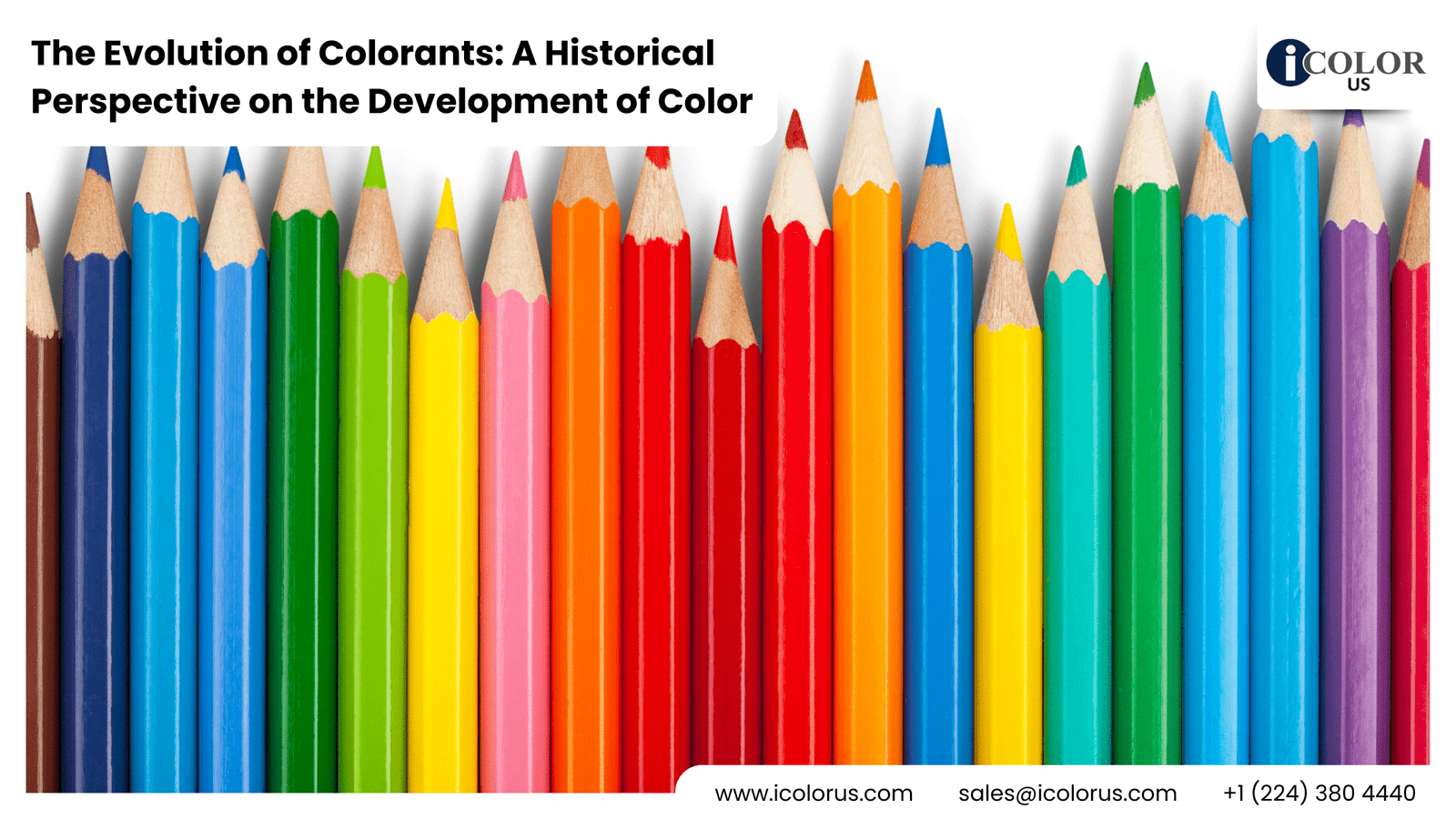Evolution of Colorants – Introduction
Colorants have played a vital role in human history, shaping the way we perceive and interact with our world. From the vibrant hues of ancient textiles to the sophisticated dyes used in modern fashion, the evolution of colorants is a testament to human ingenuity and creativity. In this article, we will take a fascinating journey through time to explore the historical development of colorants, their cultural significance, and their impact on society.
Ancient Beginnings of Colorants
Early Use of Natural Colorants
The story of colorants begins in the distant past, where early humans discovered that certain plants, minerals, and insects could produce vivid colors. These natural colorants were used to decorate bodies, pottery, and cave walls. For example, ochre, a naturally occurring pigment, was one of the earliest colorants used by humans, dating back to the prehistoric era.
First Recorded Uses in Art and Textiles
As societies evolved, so did their use of colorants. The ancient Egyptians were among the first to document the use of colorants in art and textiles. They used plant-based dyes such as indigo and madder, as well as mineral-based pigments like malachite and lapis lazuli. These colors were not only aesthetically pleasing but also held symbolic meanings, reflecting the cultural and spiritual beliefs of the time.
Colorants in Ancient Civilizations
Egyptian Innovations
The Egyptians were pioneers in the use of colorants, utilizing a variety of natural sources. Plant-based dyes were extracted from fruits, leaves, and roots, while minerals were ground into fine powders to create pigments. Colors such as blue, green, and red held significant symbolic meanings in Egyptian culture, representing life, fertility, and protection.
Mesopotamian Contributions
In Mesopotamia, the development of early synthetic colorants marked a significant advancement. These early chemists discovered methods to produce colors that were more vibrant and durable than natural dyes. The cultural significance of color was also profound, with different hues being associated with various deities and social statuses.
Classical Antiquity
Greek and Roman Era
During the classical antiquity period, the Greeks and Romans made significant strides in dyeing techniques. They sourced colorants from plants, insects, and marine animals, creating a rich palette of colors for their textiles. Techniques such as mordant dyeing, which improved colorfastness, were developed and refined during this era.
Medieval Period
European Developments
In medieval Europe, the art of dyeing was a closely guarded secret, often controlled by guilds. Natural dyeing techniques were perfected, and the trade of exotic colorants from distant lands became more common. The vibrant colors of medieval textiles were a symbol of wealth and power, often restricted to the upper classes.
Asian Contributions
Asia, particularly India and China, made significant contributions to the world of colorants during the medieval period. Indian madder and Chinese silk dyes were highly prized for their brilliance and durability. The exchange of dyeing techniques and materials along the Silk Road facilitated cultural and technological advancements in colorant production.
Renaissance and Beyond
The Renaissance period was a time of artistic rebirth and exploration, leading to new discoveries in the world of colorants. The expansion of trade routes brought exotic dyes such as cochineal and indigo to Europe, revolutionizing the palette available to artists and dyers. The increased demand for vibrant colors in art and fashion spurred further innovations in dyeing techniques.
The Age of Exploration
The Age of Exploration opened up new worlds and new sources of colorants. European explorers brought back a wealth of exotic dyes from the Americas, Africa, and Asia. These new colorants had a profound impact on European art and fashion, introducing colors and techniques previously unseen in the Old World.
Industrial Revolution
The Industrial Revolution marked a turning point in the history of colorants. The development of synthetic dyes, such as mauveine by William Henry Perkin in 1856, revolutionized the dye industry. These new dyes were cheaper, more vibrant, and more colorfast than natural dyes, making them accessible to a broader audience. The mass production of textiles in factories further accelerated the use of synthetic dyes.
20th Century Advances
The 20th century saw significant advancements in the development of modern synthetic dyes. These dyes were engineered for specific properties, such as lightfastness and washfastness, making them ideal for industrial applications. However, the widespread use of synthetic dyes also raised concerns about their environmental and health impacts, leading to increased regulation and the development of safer alternatives.
Modern Era of Colorants
Eco-Friendly and Sustainable Dyes
In recent years, there has been a growing focus on eco-friendly and sustainable dyes. Advances in biotechnology have led to the development of dyes derived from renewable sources, reducing the environmental impact of dyeing processes. These sustainable practices are becoming increasingly important in the fashion and textile industries, which are striving to minimize their ecological footprint.
Technological Innovations in Dyeing
Modern technology has revolutionized the dyeing process, making it more efficient and sustainable. Innovations such as digital printing and waterless dyeing techniques have significantly reduced water and energy consumption. These advancements are helping to create a more sustainable future for the dyeing industry.
Cultural Significance of Colorants
Colorants have always held deep cultural significance, symbolizing various aspects of life, from social status to religious beliefs. In modern times, colorants continue to play a crucial role in art, fashion, and design, influencing trends and shaping cultural identities.
Scientific Aspects of Colorants
The chemistry of colorants is a fascinating field that has evolved over centuries. Understanding the molecular structure of dyes and pigments has led to the development of new colorants with specific properties. Advances in dye chemistry continue to push the boundaries of what is possible, creating vibrant and long-lasting colors.
Economic Impact of Colorants
The colorant industry is a significant contributor to the global economy. The demand for dyes and pigments spans various sectors, from textiles and fashion to food and cosmetics. Understanding market trends and the economic impact of colorants is crucial for businesses operating in this dynamic industry.
Future of Colorants
The future of colorants lies in sustainable practices and innovative technologies. As consumers become more environmentally conscious, the demand for eco-friendly dyes will continue to grow. Innovations in dyeing techniques and the development of new, sustainable colorants will shape the future of this industry.
Conclusion
The evolution of colorants is a rich and complex journey that mirrors the progress of human civilization. From the earliest natural dyes to the sophisticated synthetic colorants of today, the quest for vibrant and lasting colors has driven technological and cultural advancements. As we move towards a more sustainable future, the story of colorants continues to unfold, reflecting our ongoing relationship with color and creativity.
FAQs
- What were the first colorants used by humans? The earliest colorants used by humans were natural substances like ochre, plant extracts, and minerals. These were used to create body paint, decorate pottery, and adorn cave walls.
- How did the Industrial Revolution change the dye industry? The Industrial Revolution introduced synthetic dyes, which were cheaper, more vibrant, and more durable than natural dyes. This revolutionized the dye industry by making colorful textiles more accessible to the masses.
- What are the environmental impacts of synthetic dyes? Synthetic dyes can have significant environmental impacts, including water pollution, toxic waste, and harm to aquatic life. Efforts are being made to develop more sustainable and eco-friendly dyeing processes.
- How are modern colorants different from ancient ones? Modern colorants are often synthetic and engineered for specific properties like lightfastness and washfastness. In contrast, ancient colorants were primarily natural substances with limited durability and colorfastness.
- What is the future of sustainable colorants? The future of sustainable colorants lies in the development of eco-friendly dyes derived from renewable sources, as well as innovations in dyeing technology that reduce water and energy consumption.





